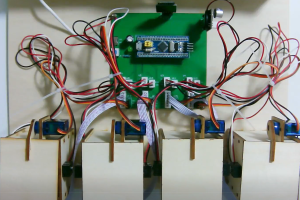设计说明书
总字数:12000+
最近几年,随着当前我国的经济不断发展,人们的生活垃圾也越来越多。智能分类垃圾桶的设计,在一定程度上可以减轻环卫工人的工作量及其环卫工作管理需要花费的财力和物力。此次设计的垃圾桶采用STM32单片机作为此次设计的主控芯片,通过4个舵机分别带动对应的垃圾桶盖,然后配合红外对射管对垃圾桶量的检测,当监测到垃圾桶满,红色指示灯点亮,反之绿色指示灯点亮,监测到垃圾桶垃圾装满时,通过WiFi模块及时将垃圾桶的信息传输到环卫管理工作人员的手机上,用户可以通过语音对各种垃圾进行识别,并打开对应的垃圾桶盖子。此次设计通过对实物的硬件和软件进行设计,最终对实现的功能和性能进行测试,使其可以具有较高的稳定性和可靠性。
关键词:垃圾桶;WiFi模块;STM32;语音播报;舵机
In recent years, with the continuous development of China’s economy, people’s household waste has also increased. The design of intelligent sorting garbage bins can to some extent reduce the workload of sanitation workers and the financial and material resources required for sanitation work management.The garbage bin in this design uses the STM32 microcontroller as the main control chip. Four servo motors drive the corresponding garbage bin covers, and then cooperate with infrared radiation tubes to detect the amount of garbage bin. When the garbage bin is detected to be full, the red indicator light will light up, and vice versa, the green indicator light will light up. When the garbage bin is detected to be full, the information of the garbage bin will be promptly transmitted to the mobile phones of environmental sanitation management personnel through the WiFi module, Users can recognize various types of garbage through voice and open the corresponding trash can lid. This design involves designing the physical hardware and software, and ultimately testing the functionality and performance of the implementation to ensure high stability and reliability.
Key words: trash can; WiFi module; STM32; Voice broadcasting; steering engine
目录
摘 要
Abstract
1绪论
1.1 选题背景及实际意义
1.2 国内外研究现状
1.3 安全与环保问题分析:
1.4 本论文研究目标与框架
2 系统设计方案
2.1 整体设计方案
2.2 主要元器件选择
2.2.1 主控芯片选择
2.2.2 电机模块方案选择
2.1.3 电源方案的选择
3 硬件设计
3.1 主控模块电路
3.2 红外对管模块电路
3.3 语音识别模块电路
3.4 WiFi模块电路
3.5 舵机模块电路
3.6 按键指示灯模块电路
4 系统程序设计
4.1 编程软件介绍
4.2 系统主流程设计
4.3 舵机模块子流通
4.4 WiFi模块子流程设计
5 实物测试
5.1 整体实物测试
5.2 语音识别控制垃圾桶实物测试
5.3 垃圾桶状态实物测试
6 结论与展望
6.1总结
6.2 安全与环保问题分析
6.3技术经济与成本分析
6.4 展望
参考文献
附录A:原理图
附录B:PCB
附录C:主程序
致谢
购买后可查看具体内容!

